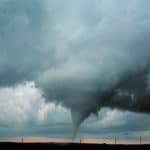Nuclear terrorism: The new day after
By Hugh Gusterson | July 23, 2007
It’s irrational to think that human beings would behave rationally in the hours and days after a nuclear terrorist attack.
A recent
New York Times opinion piece asked what we will do on the day after a nuclear terrorist
attack on the United States. The June 12 op-ed, “After the Bomb,” was written by William Perry,
Ashton Carter, and Michael May–a former defense secretary, assistant defense secretary, and
director of the Lawrence Livermore National Laboratory respectively.
They argue that, for a Hiroshima-sized bomb, “little could be done” for those within two miles
of ground zero. Survivors downwind, however, as long as they were getting good information from
government broadcasts, would be in a position to decide how many days to shelter in their basements
from radiation or to decide whether “to return to pick up a beloved pet” from their home in
exchange for increasing their lifelong chance of getting cancer to 21 or 22 percent. As for first
responders: “Few would choose to have their risk of death from cancer go up to 30 percent. But in
cases of smaller probabilities . . . a first responder might be willing to go into a radiation
zone.”
Since there might be a second bomb, the article goes on, “people in other cities might want to
evacuate on the day after, or at least move their children to the countryside, as happened in
England during World War II.” Meanwhile they advise that the U.S. government should refrain from
attacking a country, such as Russia or Pakistan, whose fissile material was in a terrorist bomb
because “their cooperation would be needed to find out who got the bombs and how many there
were.”
Have we learned nothing since 1945?
Let’s review what we know of such situations from actual historical episodes rather than from
the idealized fantasy world of defense intellectuals. A good place to begin is with Hiroshima
itself. Those who have read John Hersey’s
Hiroshima, or Robert Jay Lifton’s
Death in Life: Survivors of Hiroshima, will see the absurdity in the depiction of those
outside the two-mile radius of destruction rationally calculating the cost-benefit ratio of looking
for Fluffy the dog. Far from inhabiting a separate world from those in the two-mile-wide bull’s
eye, they would be inundated by unimaginable scenes of survivors streaming outside the radius of
immediate destruction. We know from Hiroshima that many of these people would be blinded, missing
body parts, burned beyond recognition, covered in maggot-infested wounds, clutching roasted babies
in stunned grief, screaming for water or medical help. In Richard Rhodes’
The Making of the Atomic Bomb, a girl who was five at the time remembers Hiroshima thus:
“People came fleeing from the nearby streets. One after another they were almost unrecognizable.
The skin was burned off some of them and was hanging from their hands and from their chins; their
faces were red and so swollen that you could hardly tell where their eyes and mouths were. From the
houses smoke black enough to scorch the heavens was covering the sky. It was a horrible sight.”
The survivors, even if they can tune into government broadcasts, will be making few rational
calculations. They will be utterly traumatized by the scenes of human devastation all around them,
and many will be further devastated by the loss of spouses, children, parents, or friends caught in
the eye of the nuclear storm. In such a situation some, their minds unhinged, will do stupid,
heroic things (such as heading into the radiation to look for a missing spouse’s workplace), while
others will panic and flee when they would have been better off sitting with their canned food in
the basement. If Lifton’s study of the past is prologue, many more will be too psychically
paralyzed to do anything much at all.
First responders will not be thinking much more clearly. We know from 9/11 and Chernobyl that
some will commit suicidal acts of bravery. We also know with fair certainty that some troops and
other emergency personnel, far from calculating how much radiation they choose to absorb, will, in
keeping with their uniforms, follow orders that consign them to death. In the chaos of the
situation, the risks may be unknown. Or, if the experience of the atomic veterans is anything to go
by, those giving the orders may deceive underlings about the radiation exposure they can expect,
and then cover up what happened after the fact.
As for residents of other cities who might “want to evacuate on the day after, or at least move
their children to the countryside,” this brings to mind the justly scorned plans devised under the
Reagan administration: In the event of nuclear war, those with odd and even numbered license plates
were to evacuate cities on alternate days. In a situation of mass panic, the freeways out of major
cities, already clogged to a near-standstill every day in rush hour, would–as we saw during
Katrina–freeze completely. And, anyway, where would all those people stay if they did make it out
of the cities?
Finally, there is the question of whether the U.S. government would behave with rational
restraint. This, of course, assumes that there is a government. A terrorist nuclear attack on
Washington could easily kill the president, vice president, much of Congress and the Supreme Court.
But in a July 12
Washington Post op-ed, Norman Ornstein revealed that the federal government has refused to
make contingency plans for its own nuclear decapitation, which means that U.S. nuclear weapons
could be in the hands of small, enraged launch control teams with no clear line of authority above
them. Assuming that the federal government was still there, however, we can only imagine (using the
reaction to the loss of a mere two buildings on 9/11 as a metric of comparison) the public rage at
the loss of a city and the intense, perhaps irresistible, pressure on the president to make
someone, somewhere pay for this atrocity.
We’ve been here before. In the 1950s, the years of “duck and cover” and backyard bomb shelters.
And in the Reagan years when, amidst talk of winnable nuclear wars, Pentagon official T. K. Jones
was justly ridiculed for his comment that we could survive nuclear war by digging a hole, and
topping it with a door and three feet of dirt. “If there are enough shovels to go around,
everybody’s going to make it,” he said. In the 1950s and 1980s, the American people eventually
turned against these Potemkin plans, worried that they could engender a false sense of security in
the face of the ultimate weapon.
Such hyperrational plans are at the root of our problem in the nuclear age. Since the invention
of the atomic bomb, we have surrendered control of nuclear policy to elites whose schooling in game
theory and operations research has often superseded common sense and human wisdom. As interesting
as it might be to ask what rational actors would do in the event of nuclear attack, human beings
are not rational actors. If they were, we wouldn’t have thousands of nuclear weapons in the world
today.
Together, we make the world safer.
The Bulletin elevates expert voices above the noise. But as an independent nonprofit organization, our operations depend on the support of readers like you. Help us continue to deliver quality journalism that holds leaders accountable. Your support of our work at any level is important. In return, we promise our coverage will be understandable, influential, vigilant, solution-oriented, and fair-minded. Together we can make a difference.
Topics: Columnists















